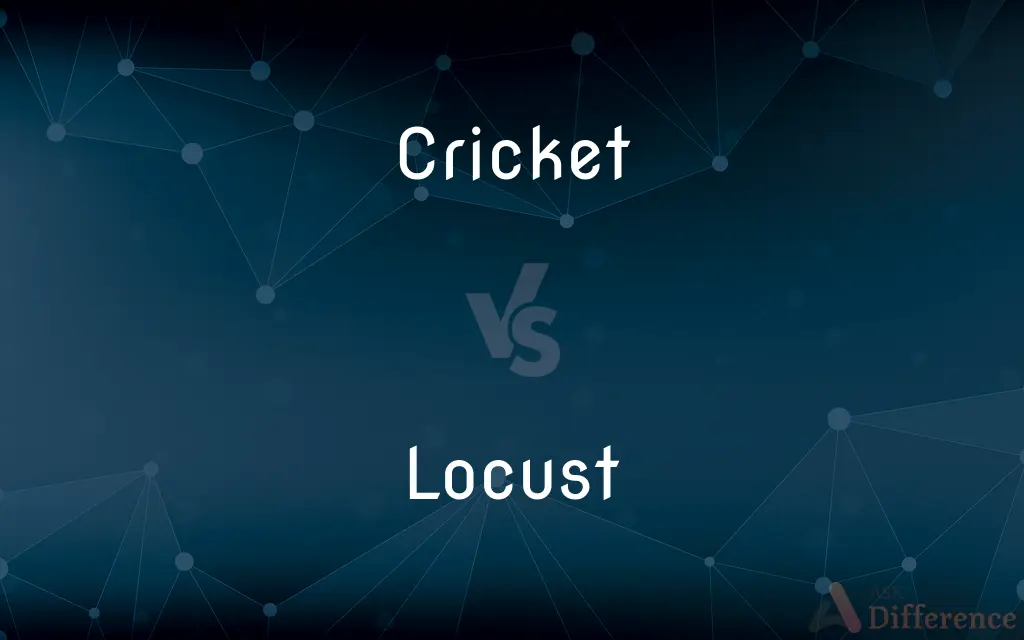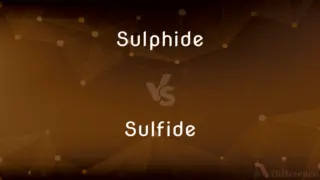Cricket vs. Locust — What's the Difference?
By Tayyaba Rehman & Maham Liaqat — Updated on March 8, 2024
Cricket is an insect known for its chirping sound, while locust is a grasshopper that can form swarms and cause significant agricultural damage.

Difference Between Cricket and Locust
Table of Contents
ADVERTISEMENT
Key Differences
Crickets are insects recognized for their distinctive chirping sounds, produced by males as a call to attract females or establish territory. They have long antennae and are typically nocturnal. In contrast, locusts are a type of grasshopper that have the unique ability to change their behavior and form large swarms when environmental conditions trigger their swarming behavior.
The physical appearance of crickets includes a more rounded body and longer antennae relative to their body size, whereas locusts have a more cylindrical body shape and shorter antennae. Another key difference is in their hind legs; while both have powerful hind legs adapted for jumping, locusts' legs are typically stronger, aiding in their ability to travel long distances during swarming.
Locust swarms are considered a significant agricultural pest due to their ability to destroy crops and vegetation over large areas, leading to food scarcity and economic loss. Crickets, on the other hand, are generally not seen as major agricultural pests, though some species can damage plants in gardens and fields.
Crickets have been a part of various cultures, often associated with good luck and fortune, particularly in East Asian traditions. Locusts, however, are often associated with plagues and destruction due to their swarm behavior and the historical impact of locust plagues on agriculture and food security.
Comparison Chart
Family
Gryllidae
Acrididae (subset of grasshoppers)
ADVERTISEMENT
Behavior
Solitary or in small groups, known for chirping.
Can form large swarms and cause agricultural damage.
Diet
Omnivorous, eating plant material and small insects.
Primarily plant material, can devastate crops in swarms.
Activity
Mostly nocturnal.
Can be active at various times, especially during swarming.
Environmental Impact
Generally benign, can be beneficial.
Can pose a significant threat to agriculture and food security.
Compare with Definitions
Cricket
Known for their chirping sounds.
The peaceful evening was filled with the chirping of crickets.
Locust
Subject to pest control efforts due to their threat to agriculture.
The government launched a locust control program to protect the harvest.
Cricket
Typically nocturnal and solitary.
Crickets are most active at night, often heard but not seen.
Locust
Behavior changes from solitary to gregarious under certain conditions.
After the heavy rains, the locusts began to exhibit swarming behavior.
Cricket
Play a role in the ecosystem by breaking down plant material.
Crickets contribute to soil health by decomposing fallen leaves and other plant matter.
Locust
Can travel long distances and devastate crops.
The locust swarm traveled hundreds of miles, leaving a trail of destruction.
Cricket
Variety of species with different habits and habitats.
Field crickets are commonly found in meadows and along roadsides.
Locust
Swarms influenced by environmental factors like drought and rapid vegetation growth.
The sudden growth of vegetation after the drought triggered a locust outbreak.
Cricket
Have long antennae and strong hind legs for jumping.
The cricket escaped danger by using its powerful hind legs to jump away.
Locust
Type of grasshopper known for forming destructive swarms.
The farmers were concerned about the incoming swarm of locusts.
Cricket
Cricket is a bat-and-ball game played between two teams of eleven players on a field at the centre of which is a 22-yard (20-metre) pitch with a wicket at each end, each comprising two bails balanced on three stumps. The batting side scores runs by striking the ball bowled at the wicket with the bat (and running between the wickets), while the bowling and fielding side tries to prevent this (by preventing the ball from leaving the field, and getting the ball to either wicket) and dismiss each batter (so they are "out").
Locust
Locusts (derived from the Vulgar Latin locusta, meaning grasshopper) are a group of certain species of short-horned grasshoppers in the family Acrididae that have a swarming phase. These insects are usually solitary, but under certain circumstances they become more abundant and change their behaviour and habits, becoming gregarious.
Cricket
Any of various orthopteran insects of the family Gryllidae, having long antennae and legs adapted for leaping. The males of many species produce a shrill chirping sound by rubbing the front wings together.
Locust
Any of various short-horned grasshoppers that sometimes migrate in immense swarms, devouring vegetation and crops.
Cricket
(Sports) An outdoor game played with bats, a ball, and wickets by two teams of 11 players each.
Locust
A cicada, especially a periodical cicada.
Cricket
Good sportsmanship and fair conduct
It's not cricket to cheat at cards.
Locust
Any of several trees of the pea family bearing long pods, especially the black locust, honey locust, and carob.
Cricket
A small wooden footstool.
Locust
The wood of any of these trees.
Cricket
A ridged structure made of two adjoining triangular pieces covered with flashing or roofing material and built at the upper intersection of a roof and chimney to divert water and prevent the accumulation of snow and debris. Also called saddle.
Locust
Any of the grasshoppers, often polyphenic and usually swarming, in the family Acrididae that are very destructive to crops and other vegetation, especially the migratory locust (Locusta migratoria).
Cricket
To play the game of cricket.
Locust
A fruit or pod of the carob tree.
Cricket
An insect in the order Orthoptera, especially family Gryllidae, that makes a chirping sound by rubbing its wing casings against combs on its hind legs.
Locust
Any of various often leguminous trees and shrubs, especially of the genera Robinia and Gleditsia; the locust tree.
Cricket
In the form crickets: absolute silence; no communication.
Locust
A cicada.
Cricket
A signalling device used by soldiers in hostile territory to identify themselves to a friendly in low visibility conditions.
Locust
A Mainlander.
Cricket
A relatively small area of a roof constructed to divert water from a horizontal intersection of the roof with a chimney, wall, expansion joint, or other projection.
Locust
(intransitive) To come in a swarm.
Cricket
An aural warning sound consisting of a continuously-repeating chime, designed to be difficult for pilots to ignore.
Locust
Any one of numerous species of long-winged, migratory, orthopterous insects, of the family Acrididæ, allied to the grasshoppers; esp., (Edipoda migratoria, syn. Pachytylus migratoria, and Acridium perigrinum, of Southern Europe, Asia, and Africa. In the United States the related species with similar habits are usually called grasshoppers. See Grasshopper.
Cricket
(sports) A game played outdoors with bats and a ball between two teams of eleven, popular in England and many Commonwealth countries.
Locust
The locust tree. See Locust Tree (definition, note, and phrases).
Cricket
An act that is fair and sportsmanlike.
Not cricket
Locust
Migratory grasshoppers of warm regions having short antennae
Cricket
A variant of the game of darts. See Cricket (darts).
Locust
Hardwood from any of various locust trees
Cricket
A wooden footstool.
Locust
Any of various hard-wooded trees of the family Leguminosae
Cricket
To play the game of cricket.
Cricket
An orthopterous insect of the genus Gryllus, and allied genera. The males make chirping, musical notes by rubbing together the basal parts of the veins of the front wings.
Cricket
A low stool.
Cricket
A game much played in England, and sometimes in America, with a ball, bats, and wickets, the players being arranged in two contesting parties or sides.
Cricket
A small false roof, or the raising of a portion of a roof, so as to throw off water from behind an obstacle, such as a chimney.
Cricket
To play at cricket.
Cricket
Leaping insect; male makes chirping noises by rubbing the forewings together
Cricket
A game played with a ball and bat by two teams of 11 players; teams take turns trying to score runs
Cricket
Play cricket
Common Curiosities
Are all grasshoppers capable of forming swarms like locusts?
No, not all grasshoppers swarm. Only specific species of grasshoppers, known as locusts, have the behavioral and physiological capacity to form swarms under certain conditions.
Can crickets cause any harm or damage?
While generally not considered major pests, some cricket species can damage plants, fabrics, and stored goods in large numbers.
What triggers locusts to form swarms?
Locust swarming is triggered by environmental factors like drought followed by rapid vegetation growth, which leads to increased contact among individuals and changes in their behavior and physiology.
How do crickets produce their chirping sound?
Crickets produce chirping sounds by rubbing their wings together, a behavior known as stridulation, primarily performed by males.
Do crickets have any beneficial roles?
Crickets contribute to the ecosystem by breaking down plant material, serving as food for other animals, and in some cultures, are even used as a protein source in human diets.
How can one differentiate a cricket from a locust visually?
Crickets generally have a more rounded body and longer antennae compared to locusts, which have a more cylindrical body and shorter antennae.
How are locust swarms controlled or managed?
Locust swarms are managed through monitoring and early warning systems, aerial and ground spraying of pesticides, and biological control methods in some cases.
What distinguishes a cricket's chirp from other insect sounds?
A cricket's chirp is distinguished by its rhythmic, repetitive nature, often increasing in frequency with higher temperatures.
What role do crickets play in cultural and artistic expressions?
Beyond their symbolism in various cultures, crickets have been featured in literature, music, and art, often depicted as characters that embody wisdom, luck, or the beauty of nature.
How do changing environmental conditions affect locust swarming behavior?
Changes in environmental conditions, such as increased rainfall after a drought, can create ideal breeding conditions for locusts, increasing the risk of swarming.
Are locusts considered a problem worldwide?
Locusts are considered a problem in many parts of the world, particularly in Africa, the Middle East, and Asia, where favorable breeding conditions can lead to large swarms.
What preventive measures can be taken against cricket infestations?
Preventive measures against cricket infestations include sealing entry points into buildings, reducing moisture and outdoor lighting that attracts crickets, and removing potential food sources.
Share Your Discovery

Previous Comparison
Esplanade vs. Promenade
Next Comparison
Sulphide vs. SulfideAuthor Spotlight
Written by
Tayyaba RehmanTayyaba Rehman is a distinguished writer, currently serving as a primary contributor to askdifference.com. As a researcher in semantics and etymology, Tayyaba's passion for the complexity of languages and their distinctions has found a perfect home on the platform. Tayyaba delves into the intricacies of language, distinguishing between commonly confused words and phrases, thereby providing clarity for readers worldwide.
Co-written by
Maham Liaqat














































